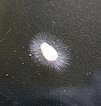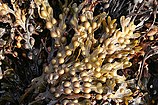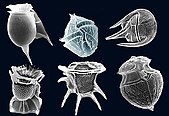| Halvaria | |
|---|---|
| Important halvarian groups. Clockwise from top-left: a water mold (Oomycetes), a brown alga (Phaeophyta), some diatoms (Bacillariophyta), some dinoflagellates (Miozoa), some ciliates (Ciliophora) and an opalinid (Bigyra). | |
| Scientific classification | |
| Domain: | Eukaryota |
| Clade: | Diaphoretickes |
| Subkingdom: | SAR |
| Infrakingdom: | Halvaria Cavalier-Smith 2010 |
| Superphyla and phyla[1] | |
| |
Halvaria is a taxonomic grouping of protists that includes Alveolata and Stramenopiles (Heterokonta).[2]
Analyses in 2007 and 2008 revealed that the Stramenopiles and the Alveolata are related, and form a reduced clade of what were seen to be a paraphyletic group, the chromalveolates. The two clades together with the Rhizaria (originally one of the six major eukaryote groups) form a clade dubbed the SAR supergroup.[3][4][5]
A phylogenomic analysis from 2016 cast doubt on Halvaria, suggesting that Alveolata is the sister group to Rhizaria (making the R + A clade) through new rhizarian sequence data, and that support for Halvaria might be an artifact of low taxon sampling as well as long branch attraction.[6]
However, later analyses from 2021 support Halvaria as a solid clade.[7]
| SAR Supergroup |
| ||||||
- ^ Cite error: The named reference
8phylawas invoked but never defined (see the help page). - ^ Cite error: The named reference
pmid20031978was invoked but never defined (see the help page). - ^ Cite error: The named reference
PhylogenomicsReshuffleswas invoked but never defined (see the help page). - ^ Cite error: The named reference
Burki2008awas invoked but never defined (see the help page). - ^ Cite error: The named reference
KimGraham2008was invoked but never defined (see the help page). - ^ Cite error: The named reference
ReducingLongBranchAlveolataRhizariawas invoked but never defined (see the help page). - ^ Cite error: The named reference
AMolecularTimescalewas invoked but never defined (see the help page).






